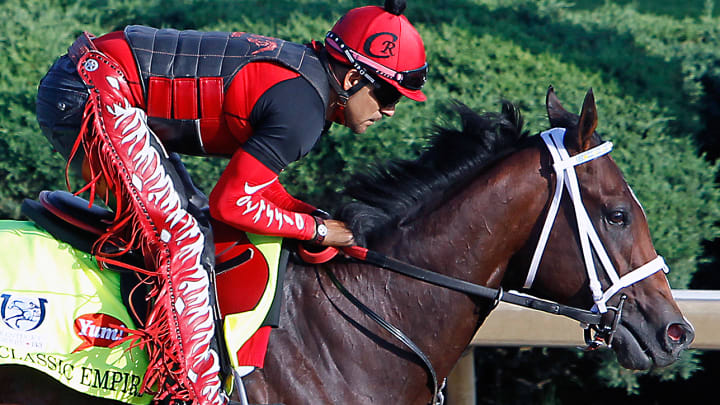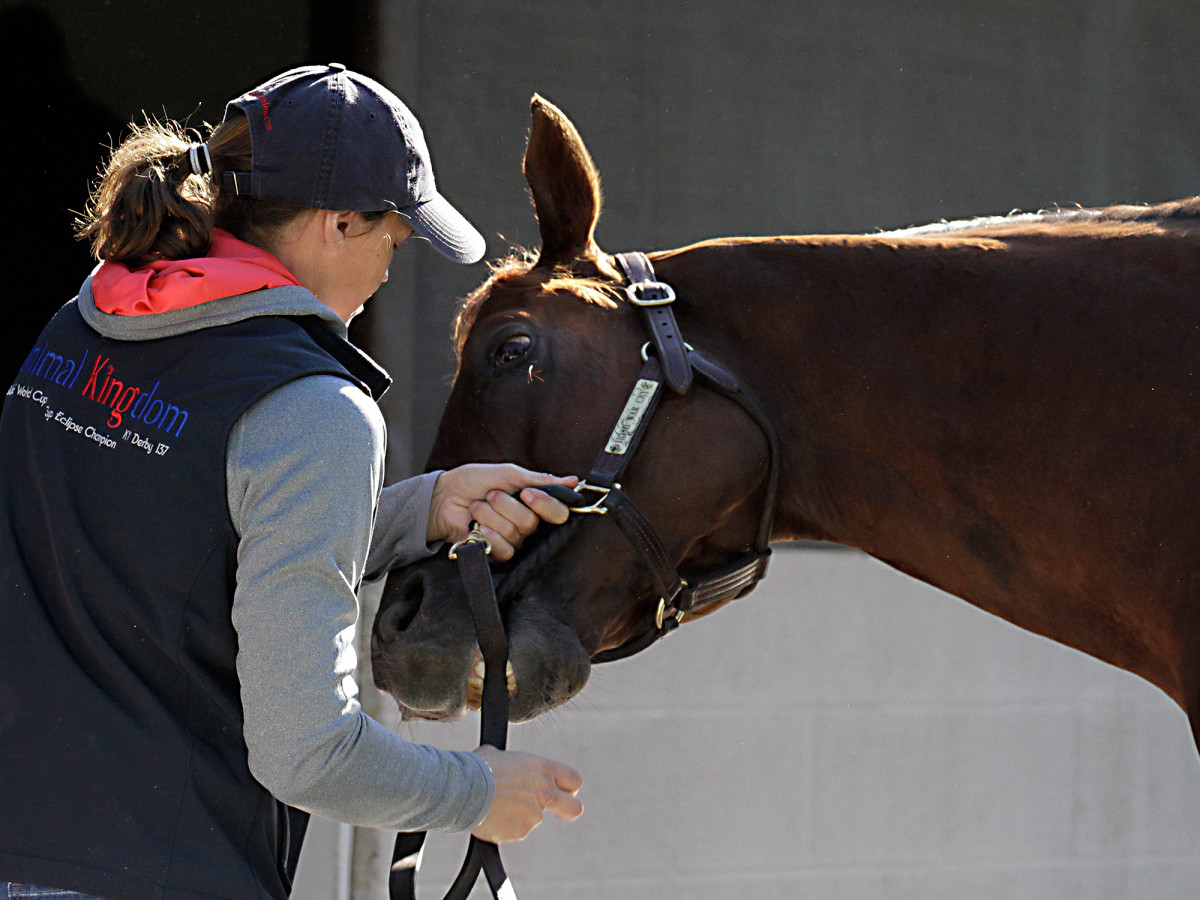Kentucky Derby offers numerous horses a chance to step to head of the class

LOUISVILLE — There are two different kinds of Kentucky Derbies. Check that. There are dozens of different kinds of Kentucky Derbies. There are Derbies run in warm sunshine and Derbies run in the cold rain. There are Derbies won by colts (most of them) and Derbies won fillies (just a few), Derbies run fast and Derbies run slow, Derbies won by horses who were leading all the way around the Churchill Downs oval and Derbies won by horses who came charging from behind in the homestretch. It’s been contested 142 times, which is sufficient sample size to cover most permutations. However, for purposes of this binary examination of the narrative and competitive angles for Saturday’s 143rd Derby, there are, indeed, two kinds of Kentucky Derbies.
(A warning here, before we get too far along. At the bottom of this column, I am going to make the obligatory sportswriter’s selection as to the one-two-three finish in the race. These selections are offered at your peril. From my first Derby in 2002 through '12, I did not pick a winner. I have turned blazing hot in recent years, with three winners in five years, all short favorites. One of the misses was American Pharoah. So there you go).
The first type of Derby is the Coronation Derby. In this scenario, the racing world arrives in Kentucky poised to crown the Next Super Horse. In a coronation Derby, one three-year-old has established his quality with a series of strong performances in the prep races, sometimes dating all the way back to his juvenile campaign. He (or she) stands poised to on the doorstep of greatness, if only he can win the Derby. This feeds conveniently into the racing ecosystem’s need to provide sentences with "Secretariat" in them, as in, "Horse Name Here’s victories in three consecutive prep races have left veteran turf writers wondering if perhaps they are looking at the next Secretariat." The thinking goes that greatness brings interloping eyeballs to racing, and there is truth in this, although those eyeballs eventually return to previously scheduled programming. Nevertheless, there is a palpable excitement in a coronation derby, the sense of witnessing the genesis of something special.
Kentucky Derby 2017: Trainers Sano, Motion among many interesting storylines
American Pharoah’s was a coronation Derby in 2015, as was California Chrome’s in '14, Big Brown’s in '08 and Smarty Jones’s in '04. (And also Secretariat’s in 1973; see, I did it). This is a not a coronation Derby, though it might have been. On March 11, Mastery won the San Felipe Stakes in California by a dominant 6¾ lengths. It was by far the best performance of the year by any three-year-old and seemed to sweep the clouds form a muddled early season. That clarity lasted only seconds. A few steps past the finish line, Mastery took an awkward step and suffered a condylar fracture of his front left ankle. It is a common injury and after surgery, Mastery might race again. But his Derby chase was over. Mastery is trained by Bob Baffert, who trained American Pharoah and whose shock of white hair is among the most familiar images in racing. Before the race, Baffert had texted me: "Mastery is pretty good. I like him." Afterward: "He had the makings of another Pharoah." (Thinking about this, it’s possible that Pharoah, in modern usage, could substitute for Secretariat in the breathless coronation paradigm, but it’s also perilous to invoke the name of Big Red in anything but hushed, reverent tones).
Anyway: This year’s Derby is not a coronation Derby. It is the second kind of Derby: The Shakeout Derby. In this case, at least a handful of horses arrive in Kentucky with promising, but flawed racing records. They have all put greatness in play, but have not sustained it.
Consider Classic Empire, the 5–1 morning line favorite. Owned by John Oxley (who owned 2001 Derby winner Monarchos) and trained by Mark Casse (with considerable assistance from his prodigal son, Norman), Classic Empire won three races as a two-year-old, including the Breeders Cup Juvenile. But he opened his three-year-old season with a dull defeat in the Holy Bull Stakes, in which he suffered a foot injury. Classic Empire subsequently balked at training and seemed hopelessly off the trail until he returned to win the April 15 Arkansas Derby, the last of the prep races. Mark Casse can only guess at the reason for the colt’s foul mood. "It’s like you’re in a car accident and you don’t want to go back to the site of the crash," says Casse. "Classic Empire hurt himself in the Holy Bull and he didn’t want to go back to the racetrack."
Is he back now?

Or Consider Irish War Cry. He won his only two starts as a two-year-old and then dominated the Holy Bull in which Classic Empire was hurt. He moved swiftly to the head of the class. But in the March 4 Fountain of Youth Stakes, he chased a fast pace and stopped, finishing seventh. Trainer Graham Motion was flummoxed, but persevered and on April 8, Irish War Cry won the Wood Memorial at New York’s Aqueduct Park. Like Casse, Motion can’t be certain what caused his horse’s failure in the Fountain of Youth. "I was actually questioning myself for running him," says Motion. "But he was such a lightly raced horse, I couldn’t imagine just sitting on him until the (April 1) Florida Derby. That performance was such an aberration, I still don’t know what to make of it."
Is he back now?
Consider McCraken, named for a town in Kansas (although that town’s name is spelled McCracken), and trained by Ian Wilkes (with ample input from Wilkes’s mentor, two-time Derby winner Carl Nafzger), has the advantage of having won his first three career races at Churchill Downs (although longtime Derby observers will explain that the Churchill surface on Derby day is a little different from any other day). McCraken opened his three-year-old season with a win in the Feb. 11 Sam Davis Stakes in Tampa. But he came out of that race with a sore ankle and didn’t race again until finishing third behind 32–1 shot Irap in the Blue Grass Stakes. "Just a slight strain, so we took our time," says Wilkes. "He’s good now."
But. Is. He. Back. Now?
And consider Gunnevera, trained by 51-year-old Venezuelan Antonio Sano, who has patiently told and re-told the harrowing story of his 2009 kidnapping while preparing the best horse he has ever touched. Gunnevera scored a stunning, stretch-running victory in the Fountain of Youth, but never rallied in a much slower-paced Florida Derby. "He didn’t like the track," says Sano, proving that bromide travels well internationally. "He’s perfect now."
But is he back?
Seldom have so many good horses loaded into the Derby starting gate with such inconsistent form. A bet on any of them is a leap of faith. Perhaps it’s a weak crop of three-year-olds. Perhaps a deep and powerful crop. Perhaps one of these colts rises above his problems and deliver the performance that defines his generation. In 2006, the Derby was considered so wide open that Sweetnorthernsaint went off as the 6–1 favorite, narrowly better than Barbaro. But Brother Derek and Lawyer Ron were also under discussion as the best of the year. Instead, Barbaro made short work of the field, running away to a 6½-length victory (before breaking down in the Preakness two weeks later).
Louisville on Derby Day offers plenty to do besides the Derby
There are exceptions this year. Like Always Dreaming, one of trainer Todd Pletcher’s three starters in the race (the 46th, 47th and 48th in his career). He started 2017 winless in two starts, but has gotten better with every race, culminating with a five-length victory in the Florida Derby. Girvin, trained by Joe Sharp and exercised in the mornings by his wife and former jockey Rosie Napravnik, has won three consecutive races, but he’s also dealing with a crack in his hoof that necessitated Sharp having him swim for exercise in the weeks leading to the Derby. Irap’s bounding, stretch-running win in the Blue Grass was one of the most impressive wins of the year and he’s owned by Paul Reddam and trained by Doug O’Neil, the same guys who won last year with Nyquist and five years ago with I’ll Have Another. But the Blue Grass was the first win of his life after eight races. Hence won the Sunland Derby six weeks ago and he’s trained by the prolific Steve Asmussen, who is bound to win a Derby some day. But the Sunland Derby has only produced one Derby winner, 50–1 shot Mine That Bird in 2009.
The list goes on. Tapwrit won the Tampa Bay Derby for Pletcher, but was a lousy fifth in the Blue Grass. (Pletcher’s third starter, Patch, has one eye). Gormley, from the Zenyatta team of trainer John Shireffs and owner Jerry Moss, won the Santa Anita Derby with a long, grinding stretch run. J Boys Echo, trained by Louisville native Dale Romans, won the Gotham Stakes in New York, but laid an egg in the Blue Grass.
Confusing the issue even further, there seems to be no obvious speed horses in the race. Customarily, the Derby’s 20-horse field includes equal numbers of horses who start fast, stalk the pace or come from behind. (The entry-by-points system that sorts out the field from among countless owners with Derby Fever tends to knock out speedballs, because they can’t win long races). This year seems to be thick with horses who would all like to be in third place and then make a move. Somebody will lead. Maybe somebody will steal the Derby, as Baffert’s War Emblem did in 2002. But it hasn’t happened since.
The parity of the field and uncertainty of the pace make for wonderful betting options. Here’s one possibility:
1. Irish War Cry
2. Classic Empire
3. Gormley
